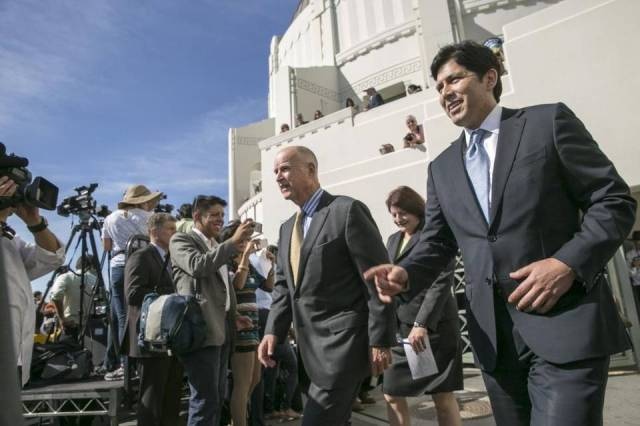Apr 7 2016
Making our homes and businesses more energy efficient should be a no-brainer. Switching out incandescent light bulbs, upgrading our heating and air-conditioning systems and other improvements save energy and money, and reduce pollution.
 Gov. Jerry Brown, center, arrives last October at Griffith Observatory with Senate President Pro Tem Kevin De León, right, and then-Assembly Speaker Toni Atkins, to sign landmark legislation to increase the state's renewable electricity use to 50 percent and doubling energy efficiency in existing buildings by 2030. Damian Dovarganes Associated Press file
Gov. Jerry Brown, center, arrives last October at Griffith Observatory with Senate President Pro Tem Kevin De León, right, and then-Assembly Speaker Toni Atkins, to sign landmark legislation to increase the state's renewable electricity use to 50 percent and doubling energy efficiency in existing buildings by 2030. Damian Dovarganes Associated Press file
Yet despite billions of dollars in taxpayer- and ratepayer-funded incentives and rebates, our efficiency efforts in California aren’t keeping pace with increasing electricity demand.
If we don’t make better progress, we won’t be able to achieve our long-term climate and energy goals. We’re also leaving a lot of money on the table. A recent state-commissioned study indicates there is two to three times greater economic efficiency potential in existing buildings than what is achievable via current programs that rely on rebates and incentives.
To date, California has relied on these programs, which encourage rather than require the adoption of energy-efficient equipment and monitoring. Yet they have been unable to achieve the deep reductions in energy use we need.
A solution might be to emulate the success of rooftop solar. It has spread quickly in part because many companies offer no-money-down, long-term loans, backed by capital market investment. The same financing could work with energy-efficiency retrofits, since they also promise to reduce electricity bills at a steady rate.
So why is private capital sitting on the sidelines? Because, unlike with solar panels, we haven’t been able to reliably measure the energy we don’t use due to energy-efficiency measures in buildings – and provide the documented, standardized savings to attract large-scale financing.
Fortunately, technology is coming to the rescue. New software and methodologies can more accurately measure and verify the energy saved through efficiency improvements, and can account for a variety of factors, such as weather and building use.
But without a uniform, state-sanctioned methodology and technology standard, utilities will be reluctant to base incentives on the measured efficiency gains.
The state has an opportunity to remedy the problem. A new law, Assembly Bill 802, authorizes investor-owned utilities to experiment with advanced meters designed to measure savings.
As I argue in a new report, regulators should seize this chance to encourage utilities to develop aggressive energy-efficiency projects based on these emerging technologies.
Ultimately, the state will need to rethink the complex, consumer-financed energy-efficiency model and move toward simpler approaches that rely on emerging technologies. Given the need, now is the time to act boldly and seize the policy and technology opportunities in front of us.
Source: http://www.sacbee.com/